Thuja Occidentalis Brabant Growth
A delightful evergreen shrub needing low maintenance and a native of the northern U.S., Thuja occidentalis Brabant (White Cedar, Brabant variety) is a member of the Cypress family. According to the U.S. Department of Agriculture, White Cedar cultivars are often used in landscaping and for hedges, with the Brabant cultivar a known urban success. Healthy Thuja occidentalis Brabant growth depends on the type of soil, location, pruning, watering and avoidance of pests. The plant is generally adaptable once established, making it an excellent choice for landscape design and urban enhancement.
Plant Size and Shape
The Brabant cultivar will reach a height of 12 feet and a width of 5 feet at maturity. Unlike its tree cousins, which can live for 400 years or more, the Brabant cultivar, used in landscaping, grows at a rate of 60 inches a year and can be expected to live for 40 years or more with proper maintenance. According to the Ohio State University Horticulture and Crop Sciences Department, there is a tendency toward widening at the base with maturity, causing separate canopies to form and leaving bare areas.
- A delightful evergreen shrub needing low maintenance and a native of the northern U.S., Thuja occidentalis Brabant (White Cedar, Brabant variety) is a member of the Cypress family.
- According to the U.S. Department of Agriculture, White Cedar cultivars are often used in landscaping and for hedges, with the Brabant cultivar a known urban success.
Propulgation
Like other Thuja occidentalis cultivars, the cultivar Brabant is propagated primarily by rooted stem cuttings. Young shrubs are available in burlap balls or containers through gardening stores and online. Layering is another way additional trees may form. Adventitious roots can be produced by branches or stems, or from trees that have been uprooted but retain roots at the soil site, as stated by the USDA, Natural Resources Conservation Service.
Soil and Sun Preference
Generally preferring swampy areas in Hardiness Zones 3 to 7, Thuja occidentalis Brabant does well in wet soils and tolerates sandy soils. Acidic and alkaline soils are also tolerated. This cultivar prefers moist air and full sun. Keep in mind that these plants tend to become thin in partial shade and do poorly in full shade. All cultivars of Thuja occidentalis, the Brabant cultivar included, are highly urban tolerant and can sustain periods of heat, drought and poor soils. However, careful maintenance can ensure healthy plants.
- Like other Thuja occidentalis cultivars, the cultivar Brabant is propagated primarily by rooted stem cuttings.
- All cultivars of Thuja occidentalis, the Brabant cultivar included, are highly urban tolerant and can sustain periods of heat, drought and poor soils.
Maintenance
Pruning requirements are minimal, and consist of removing dieback and trimming back new growth as needed for shaping. Of the many cultivars of Thuja occidentalis, the Brabant cultivar forms one central leader, assisting the plant to sustain winter snows without significant breakage. This alleviates the need to tie leaders together to prevent breakage from snow damage. Even though the plant can sustain drought and heat, it's best to keep soil moist and roots watered.
Pests
Thuja occidentalis Brabant, like other White Cedars, is susceptible to several pests, including the leaf miner, spider mites and bag worms. Deer are known to heavily feed off Thuja occidentalis. Unlike other White Cedar cultivars, the Brabant provides some defense against snow damage with its central leader. Although insecticides can kill the leaf miner and bag worms, use of insecticides opens up susceptibility of the plant to spider mites, which flourish when insecticides kill off their natural predators, according to a Colorado State University Extension paper on Spider Mites. However, White Cedars can withstand deep injury due to pests, although affected areas may not retain the same aesthetic appeal.
- Pruning requirements are minimal, and consist of removing dieback and trimming back new growth as needed for shaping.
- Although insecticides can kill the leaf miner and bag worms, use of insecticides opens up susceptibility of the plant to spider mites, which flourish when insecticides kill off their natural predators, according to a Colorado State University Extension paper on Spider Mites.
